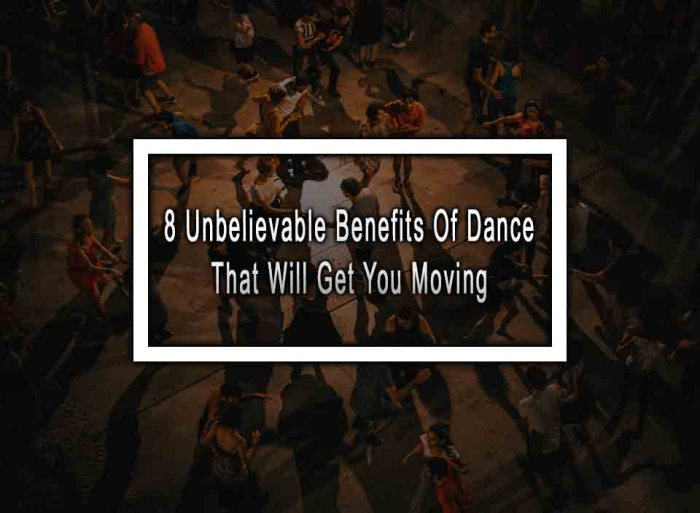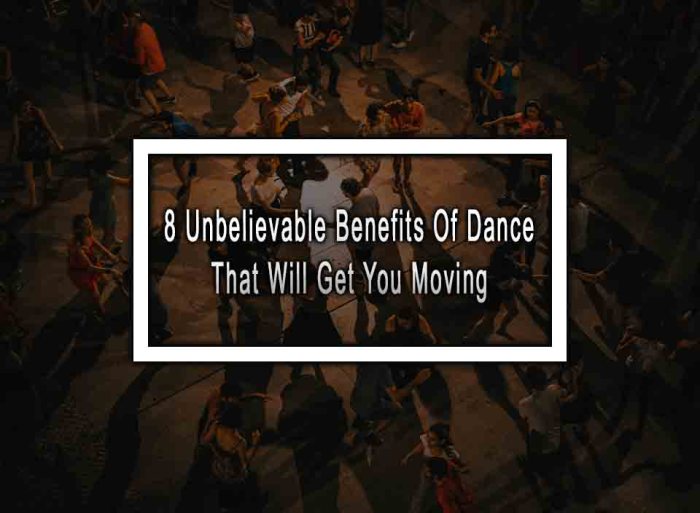4 extraordinary benefits only people that grew dancing know. Dancing isn’t just a hobby; it’s a transformative experience that shapes a person from the inside out. From enhanced body awareness to unlocking creativity, the profound impact of dance training is undeniable. This exploration delves into the extraordinary benefits only those who grew up dancing truly understand.
Imagine a world where coordination isn’t just a skill, but an intuitive extension of your being. This is the world of dancers, where every movement is a conversation with your body. This deep connection extends far beyond the studio, shaping everyday interactions with grace and precision.
Enhanced Body Awareness and Coordination
Dancing isn’t just about graceful movements; it’s a profound exploration of the body. Through rigorous training, dancers develop an exceptional level of body awareness, enabling them to control their movements with precision and fluidity. This heightened awareness extends far beyond the dance floor, impacting coordination, spatial understanding, and overall well-being. This intricate connection between mind and body is one of the most significant benefits of dance training.The meticulous practice of dance fosters a deep understanding of the body’s capabilities and limitations.
Dancers learn to recognize subtle shifts in posture, balance, and muscle engagement. This constant awareness, honed over years of dedicated practice, translates to improved coordination and precision in daily activities. Imagine effortlessly navigating a crowded room, or smoothly adjusting your posture while working at a desk – these seemingly simple actions become significantly more effortless for someone with a strong sense of body awareness.
How Dance Cultivates Body Awareness
Dance training utilizes a wide range of techniques to cultivate body awareness. From intricate ballet steps to dynamic contemporary movements, each exercise challenges dancers to engage specific muscle groups and understand their interactions. This detailed understanding of body mechanics is crucial for maintaining proper posture, balance, and efficient movement. Furthermore, dancers constantly refine their spatial awareness, learning to anticipate and react to their surroundings and the positioning of their body in relation to the space around them.
This continuous refinement of spatial and body awareness is a key element in developing a profound sense of self-control.
Examples of Enhanced Coordination
Dancers often demonstrate remarkable coordination in daily life. For instance, they frequently exhibit improved dexterity, as their hands and feet move in sync with intricate timing and precision. Their spatial awareness allows them to navigate obstacles or crowds more easily, avoiding collisions and moving with fluidity. Similarly, their enhanced sense of balance translates to better posture and reduced risk of falls, even in non-dance-related activities.
Everyday tasks like tying shoelaces or reaching for objects become more efficient and precise, reflecting the honed coordination gained through dance.
Body Awareness Comparison: Dancers vs. Non-Dancers
| Characteristic | Dancers | Non-Dancers |
|---|---|---|
| Body Awareness | High, sensitive to subtle shifts in posture, balance, and muscle engagement. | Generally lower, less conscious of subtle body mechanics. |
| Spatial Awareness | Exceptional, accurately perceives and reacts to their surroundings in relation to their body position. | Variable, often less attuned to spatial relationships. |
| Coordination | High, demonstrates precision and fluidity in movement, both on and off the dance floor. | Generally lower, movements may lack precision or smoothness. |
| Posture | Typically better posture, maintained with awareness and effort. | Posture may be less consciously maintained, potentially leading to imbalances. |
“The body is a vessel for the soul, and dance is the language.” – Unknown
Improved Self-Expression and Confidence: 4 Extraordinary Benefits Only People That Grew Dancing Know
Unleashing your inner artist through dance isn’t just about graceful movements; it’s a powerful journey of self-discovery. Dance provides a unique language that transcends words, allowing individuals to communicate emotions, build confidence, and navigate their inner worlds with newfound clarity. It’s a process of continuous growth and transformation, shaping not only physical abilities but also emotional intelligence and self-perception.Beyond the physical, dance cultivates a profound connection to oneself.
The act of learning and performing, whether solo or in a group, fosters a sense of accomplishment and empowerment. This process, often fraught with challenges and triumphs, instills resilience and a belief in one’s capabilities. It’s a pathway to improved emotional regulation, helping individuals to manage stress and cultivate a positive mindset.
Dance as a Platform for Self-Expression
Dance is a universal language, a powerful medium for self-expression that transcends linguistic barriers. Through movement, posture, and gestures, dancers communicate a wide spectrum of emotions, experiences, and ideas. Whether it’s the passionate intensity of flamenco, the graceful fluidity of ballet, or the rhythmic energy of hip-hop, each dance form offers a unique avenue for self-expression.
Building Confidence and Self-Esteem Through Dance
The process of learning and performing dance is inherently challenging, requiring dedication, discipline, and perseverance. Conquering these challenges, whether mastering a complex step or overcoming stage fright, builds confidence and self-esteem. The sense of accomplishment derived from consistent practice, the appreciation of one’s progress, and the positive reinforcement from instructors and peers all contribute to a positive self-image.
Ever wondered what’s so special about those who’ve danced their whole lives? Four extraordinary benefits come to mind, like improved coordination and discipline. But did you know that a balanced diet, including considering the question of should you eating meat fish , is also crucial for dancers? Ultimately, these benefits, honed through years of practice, are what set dancers apart.
The process fosters a deeper understanding of one’s strengths and weaknesses, ultimately leading to a more confident and self-assured individual.
Impact of Dance on Emotional Regulation and Stress Management
The physical exertion and focused concentration required in dance have a profound impact on emotional well-being. Dance acts as a powerful stress reliever, channeling pent-up energy and releasing endorphins, which have mood-boosting effects. The rhythmic nature of dance can be incredibly meditative, allowing individuals to find a sense of calm and focus amidst the chaos of daily life.
This emotional regulation can positively impact stress management, allowing individuals to approach challenges with greater resilience and composure.
So, four amazing perks of growing up with dance? You develop incredible discipline and focus, vital skills for life. Plus, the constant movement keeps your body healthy and strong. Finding healthy alternatives to those tempting unhealthy snacks is also important. Check out more unhealthy snacks try these tasty alternatives for some delicious ideas.
And finally, dancing teaches you about teamwork and collaboration, invaluable life lessons. These benefits truly shape who you are.
Different Dance Forms and Their Potential for Self-Expression
Various dance forms offer unique opportunities for self-expression. Here’s a glimpse into some of them:
- Ballet: Characterized by grace, precision, and elegance, ballet often explores themes of love, loss, and heroism. The controlled movements and structured choreography allow dancers to communicate complex narratives through their bodies.
- Hip-Hop: A dynamic and energetic dance form, hip-hop is deeply rooted in social commentary, personal experiences, and cultural expression. The improvisational nature of hip-hop allows for a high degree of self-expression, with dancers able to showcase their individuality through intricate footwork and powerful movements.
- Jazz: Combining elements of classical ballet and modern dance, jazz is characterized by its improvisational nature and expressive qualities. The rhythmic and energetic movements, combined with a wide range of emotions, make it a versatile medium for self-expression.
- Tap: A dance form emphasizing percussive footwork, tap allows for a unique and rhythmic expression. The precise tapping of the feet, combined with intricate patterns, provides a form of auditory self-expression.
- Contemporary: A modern dance form that emphasizes emotional expression and physical exploration. Contemporary dance often uses a wider range of movement, including contortions and improvisational gestures, providing a highly personalized and expressive experience.
Stronger Discipline and Focus

Beyond the graceful movements and captivating artistry, dance demands a profound level of discipline. This dedication isn’t just about mastering steps; it’s a commitment to consistent practice, unwavering focus, and the ability to push past perceived limits. The rigorous training cultivates a powerful inner strength that extends far beyond the studio.The training in dance fosters an extraordinary level of self-discipline.
This discipline isn’t merely about adhering to a schedule; it’s about internalizing a mindset of dedication and perseverance. Students learn to prioritize practice over distractions, to push through fatigue and discomfort, and to consistently strive for improvement. This dedication is crucial for achieving mastery in any art form.
The Disciplined Dance Student
The demands of dance training extend far beyond memorizing steps and routines. It requires a rigorous commitment to practice, encompassing everything from mastering complex choreography to refining posture, strength, and flexibility. The process necessitates meticulous attention to detail, as even the smallest errors can significantly affect the overall performance.
Fostering Perseverance and Dedication, 4 extraordinary benefits only people that grew dancing know
Dance training provides a unique crucible for developing perseverance and dedication. Students learn to overcome setbacks, whether it’s a difficult combination of steps or an injury that temporarily halts progress. This process instills resilience and the ability to bounce back from adversity, a valuable life skill applicable to all endeavors. For example, a dancer who struggles with a particular pirouette will persevere through countless repetitions, gradually mastering the technique through sheer dedication.
Comparing Dance Discipline to Other Disciplines
While the discipline in dance shares similarities with other demanding fields like sports or academics, there are also significant differences. All three require focused effort, dedication, and a commitment to improvement. However, dance’s emphasis on artistic expression and the integration of physical and mental skills sets it apart. In sports, the focus is primarily on physical prowess, while academics concentrate on intellectual pursuits.
Dance, on the other hand, integrates both physical and mental aspects, demanding a unique blend of discipline and artistry. Students must not only train their bodies but also develop their creativity and emotional intelligence.
Four extraordinary benefits come from a dance background. One key is the ability to bounce back from setbacks. Like any art form, dancing involves a lot of trial and error, and learning to accept failures without questioning your abilities is crucial. This directly translates to a mentally strong person’s mindset, as detailed in this insightful article on mentally strong people mindset accept failures without doubting yourself.
Ultimately, those who grew up dancing develop resilience and a unique capacity for self-belief, making them exceptionally adaptable and focused.
Table: Comparing Discipline, Focus, and Dance Techniques
| Discipline | Focus | Specific Dance Techniques |
|---|---|---|
| Strict adherence to practice schedule and routine | Maintaining concentration during long practice sessions, focusing on precision in each movement | Barre work, center combinations, and challenging choreography |
| Overcoming physical limitations and pushing past discomfort | Maintaining focus despite fatigue or pain | Difficult leaps, turns, and lifts; maintaining balance and control in demanding sequences |
| Cultivating a growth mindset and embracing challenges | Sustaining attention and motivation despite encountering setbacks or difficulties | Mastering intricate steps and patterns; refining and perfecting existing techniques |
Creativity and Problem-Solving Skills

Unleashing your inner artist isn’t confined to the canvas or the stage. Dance, in its essence, is a potent catalyst for creative thinking and problem-solving. Through the dynamic interplay of movement, rhythm, and improvisation, dancers cultivate a unique skillset that transcends the realm of physical performance. This skillset translates directly into enhanced cognitive abilities, fostering innovative approaches to challenges in all aspects of life.The act of creating a dance routine, whether solo or collaborative, requires a unique process of ideation, exploration, and refinement.
Each movement is a potential solution, each sequence a pathway to an artistic expression. This iterative process, inherent in dance practice, mirrors the problem-solving approach of identifying a problem, exploring various solutions, and refining the most effective one.
Dance as a Creative Process
Dance fosters a mindset of exploration and experimentation, where the possibilities are as boundless as the dancer’s imagination. This exploration often leads to unexpected solutions and innovative ideas. The very nature of dance improvisation, for instance, encourages the generation of novel sequences and interpretations in real-time, pushing the boundaries of creative expression. This spontaneity, though seemingly unstructured, is deeply rooted in a structured understanding of movement principles and techniques.
Techniques Promoting Creative Problem-Solving
A multitude of dance techniques directly contribute to creative problem-solving. For instance, contemporary dance, with its emphasis on freedom of movement and expression, encourages the exploration of unconventional movements and interpretations. Similarly, ballet, despite its structured format, necessitates the ability to interpret musical cues and translate them into unique, expressive movements.
- Spatial Awareness: Understanding and manipulating space is crucial in dance. This involves visualizing movements in relation to others and the environment, a skill directly applicable to problem-solving in various contexts, from architectural design to strategic planning.
- Musicality: Responding to the rhythm and melody of music is fundamental to dance. This ability to interpret and adapt to musical cues translates into adapting to changing situations and finding solutions that resonate with the circumstances.
- Improvisation: The ability to create spontaneously is a powerful tool for problem-solving. In dance, improvisation involves generating new movement sequences on the spot, a skill that builds adaptability and quick thinking.
- Collaboration: Many dance forms are collaborative. This requires dancers to communicate effectively, build consensus, and adapt to the ideas and contributions of others. This fosters cooperation and creative synergy in finding solutions.
Framework for Enhancing Creative Thinking Through Dance
Developing a framework for enhancing creative thinking through dance practice involves several key steps.
- Establish a Creative Mindset: Encourage a mindset of exploration, experimentation, and risk-taking in dance practice. This includes encouraging dancers to break free from traditional patterns and embrace novelty.
- Focus on Improvisation: Integrate improvisation into dance sessions to encourage the generation of spontaneous ideas and movements. This can be facilitated through prompts or challenges.
- Utilize Musicality: Explore how music influences movement. Encourage dancers to use musical cues to generate movement ideas and to respond to the music’s dynamic qualities.
- Foster Collaboration: Encourage group dance projects that involve shared creativity and problem-solving. This will help dancers learn to incorporate others’ perspectives and build consensus.
- Refine and Evaluate: Include time for reflection and evaluation in the dance process. This involves analyzing the strengths and weaknesses of created routines and identifying areas for improvement. This critical evaluation enhances creative problem-solving in all domains.
Physical Well-being and Health
Beyond the aesthetic appeal and self-expression, dance offers a remarkable pathway to enhanced physical well-being and overall health. It’s a dynamic activity that engages the entire body, promoting strength, flexibility, and cardiovascular health in a fun and engaging way. The benefits extend far beyond just physical fitness, impacting mental well-being and overall quality of life.Dance’s impact on physical fitness is multifaceted.
It’s not just about moving; it’s about coordinating movements, building strength, and improving cardiovascular health. Each dance style, from ballet’s precise steps to hip-hop’s dynamic improvisations, challenges the body in unique ways, resulting in a range of benefits for overall health and well-being.
Cardiovascular Health
Dance is a fantastic cardiovascular workout. The continuous movement and varying intensity of different dance styles increase heart rate, improve blood circulation, and strengthen the heart muscle. This is especially beneficial in preventing cardiovascular diseases, such as heart attacks and strokes. Studies have shown that regular dance participation can lead to a reduction in blood pressure and cholesterol levels.
Flexibility and Strength
Dance requires a wide range of movements, from stretching to leaps and turns. This constant stretching and strengthening of muscles improves flexibility, balance, and posture. Different dance styles emphasize different muscle groups, building strength and endurance in unique ways. For instance, ballet emphasizes core strength and leg muscles, while contemporary dance often focuses on upper body strength and flexibility.
Maintaining a good range of motion is crucial for everyday activities and reduces the risk of injuries.
Maintaining a Healthy Weight and Preventing Health Issues
Dance is an excellent way to burn calories and maintain a healthy weight. The intensity and duration of dance sessions can be tailored to individual needs and fitness levels, making it a suitable exercise for people of all ages and backgrounds. Beyond weight management, dance can help prevent various health issues, such as osteoporosis and arthritis. The constant movement and strengthening of bones through dance can help maintain bone density and reduce the risk of these conditions.
Table of Physical Benefits of Different Dance Forms
| Dance Form | Cardiovascular Benefits | Flexibility Benefits | Strength Benefits |
|---|---|---|---|
| Ballet | Excellent cardiovascular workout, especially through fast-paced routines. | Exceptional flexibility, particularly in the legs and feet. | Builds strong core, leg, and arm muscles. |
| Hip-Hop | High-energy, dynamic movements provide significant cardiovascular benefits. | Improves flexibility and range of motion, especially in the lower body. | Develops strength in legs, core, and upper body, with emphasis on quick movements. |
| Salsa | Increases heart rate and improves stamina through rhythmic movements. | Enhances flexibility and coordination in the hips and legs. | Strengthens core, leg, and hip muscles. |
| Zumba | High-intensity cardio workout, excellent for burning calories and improving cardiovascular health. | Improves flexibility and range of motion in various body parts. | Strengthens major muscle groups through varied and rhythmic movements. |
Conclusive Thoughts
In conclusion, the journey of growing up with dance is a unique one, enriching lives with a plethora of benefits. From mastering physical and mental discipline to unlocking creativity and self-expression, the impact of dance is far-reaching. The benefits extend beyond the studio, impacting daily life with a newfound awareness, grace, and confidence. This experience truly shapes a person’s overall well-being.







